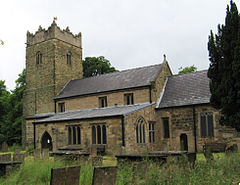Teversal
This article needs additional citations for verification. (December 2009) |
| Teversal | |
|---|---|
 | |
Location within Nottinghamshire | |
| OS grid reference | SK484619 |
| District | |
| Shire county | |
| Region | |
| Country | England |
| Sovereign state | United Kingdom |
| Post town | SUTTON-IN-ASHFIELD |
| Postcode district | NG17 |
| Dialling code | 01623 |
| Police | Nottinghamshire |
| Fire | Nottinghamshire |
| Ambulance | East Midlands |
| UK Parliament | |
Teversal is a small village in the Ashfield district of Nottinghamshire, England, located 3 miles west of Mansfield, close to the Derbyshire border. It is in the town of Sutton-in-Ashfield. Former names include Tevershalt, Teversholt, Tyversholtee, Teversale, Tevershall and Teversall.[1]
St Katherine's Church is a Grade I listed building.
The Teversal Trails are a series of trails on the route of old railway lines. The Teversal Trails Visitor Centre is located on Carnarvon Street in a large car park that serves the Teversal Football, Teversal Cricket and Teversal Bowls clubs. Teversal (called Tevershall) is the site of Wragby Hall where Clifford and Connie Chatterly lived in the D.H Lawrence novel, Lady Chatterly's Lover. This book gives good detail of the life of Tevershall colliery and colliers, although it is not clear if the coal mine, and the nearby Stacks Gate Colliery, described in the novel, actually existed.
Teversal was the home of the fictional Lady Chatterley in the novel Lady Chatterley's Lover by D. H. Lawrence.[2]
References
- ^ Faulkes, Heather (22 April 2004). "A History of Teversal". Retrieved 3 January 2010.
- ^ The Nottinghamshire Village Book (Newbury: Countryside Books, 1989), p. 157.
External links

